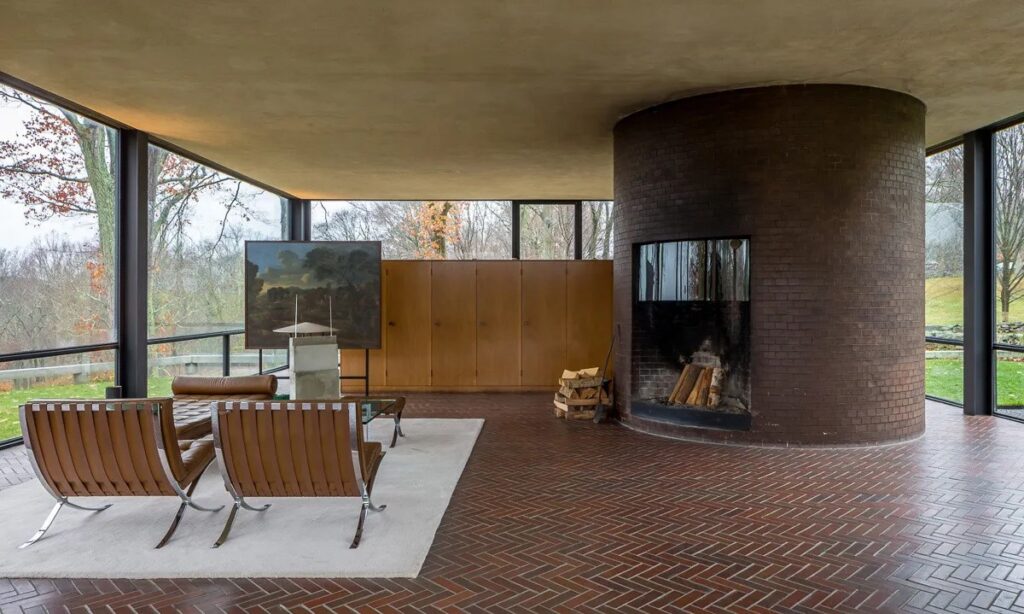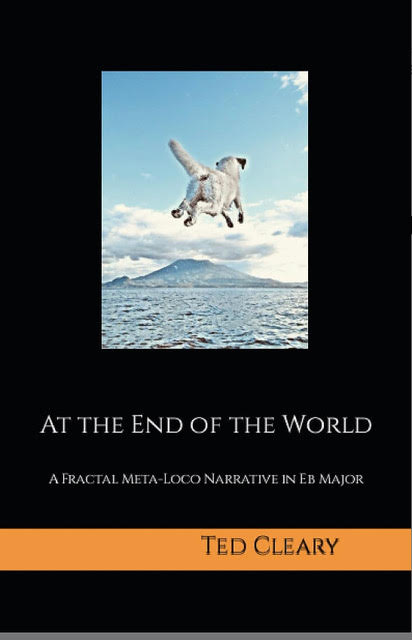Support this blog by visiting Jim’s Patreon Page or Substack
And thanks to all my Patrons for your support!
The austere glass box sited on a ridge in New Canaan, Connecticut, is the iconic Glass House designed by Philip Johnson (1906-2005). Born to a fortune, he helped finance New York’s Museum of Modern Art (MOMA), and was made curator of its Architecture Department in the early 1930s, where he would publicize the work of the Modernists — Ludwig Mies van der Rohe, Marcel Breuer, and Walter Gropius, who would soon flee Germany for America. By a strange irony, Johnson became an admirer of Adolf Hitler. He soon quit MOMA and started writing magazine articles praising the Nazi program. After attending a Nuremberg rally in 1932, he remarked to his biographer, Franz Schulze, “You simply could not fail to be caught up in the excitement of it, by the marching songs, by the crescendo and climax of the whole thing, as Hitler came on at last to harangue the crowd. . . all those blond boys in black leather” marching past the Führer.
That venture didn’t work out so well, and after the big war, Johnson made another career move back into architecture. The Glass House (1948-49) was an early stunt in that phase of his life, garnering Johnson adulation for his purity and simplicity. Mid-20th century Modernism worked tirelessly to wipe the slate clean of any architectural reference to history (and, of course, the Nazis had promoted an aerodynamic neo-classicism that was a type of Art Deco, now verboten). Journalists have noted that Johnson’s Glass House was likely a rip-off of Mies’s design for the also-iconic Farnsworth House in Illinois, designed around the same period but built a few years later.
What you see here is symptomatic of the cultural neurosis that has corroded Western Civ in the decades since: a house that does not make a distinction between the inside and the outside — that is, a house that explicitly states it is “not shelter.” This has been understood as “cutting edge” and “progressive” for three quarters of a century. The confusion was so brazen that at one point, Johnson had to hire an off-duty policeman to stand by and chase gawkers away. A sign on the driveway said: “This House Is Now Occupied Please Respect the Privacy of the Owner. It will be Open to the Public on specified days.”
Similarly, the house tries to demonstrate that views of “nature” are an adequate substitute for the neurological imperatives of humans to seek shelter. (Even campers have walls on their tents.) Or for buildings to express decorum artistically on their exteriors. Rather, what ends up on display in the Glass House is human behavior inside with no decorum whatsoever — only made possible by the aristocratic privilege of being surrounded by a large wooded estate.
Johnson actually died there in 2005 — he must have truly loved it — and left the building and its 52-acre property to the National Trust for Historic Preservation. The interior had all the charm of an airport lounge. Easy to vacuum the floors, though.





 JHK’s Three-Act Play
JHK’s Three-Act Play









You’re being far to generous with the “airport lounge” description.
This “vision” didn’t make it inside from the parking garage.
I guess you could call it ‘iconic’ instead of moronic. Frank Lloyd Wright had his ‘Prairie’ style, and here, Johnson seems to have unabashedly created an offshoot called ‘Prairie Glass’ style.
You can imagine that many must have wondered, “where would I take a dump”? Well, unlike any bears that may inhabit the property, you need not follow their example, but rather enter that big cylinder and find yourself ensconced in a not so lavish loo done in somewhat attractive blue-green mini tiles.
Johnson’s idea regarding furniture seems to have been to use it sparingly, maybe having some sort of premonition about his giant ‘Chippendale’ highboy in NYC, otherwise known as the AT&T building. Robert Venturi also had some questions about the originality of Johnson’s foray into furniture.
I could understand Johnson being moved at the Nuremburg rally, especially if he heard Wagner’s Overture to “Rienzi”, the musical theme for Nazi Party rallies.
Alain de Botton wrote a book titled, “The Architecture of Happiness”. He talks about architecture in a human, personal context. “What we search for in a work of architecture is not in the end so far from what we search for in a friend”. “Bad architecture is in the end as much a failure of psychology as of design. It is an example expressed through materials of the same tendency which in other domains will lead us to marry the wrong people, choose inappropriate jobs, and book unsuccessful holidays: the tendency not to understand who we are and what will satisfy us”.
This glass box has nothing inspirational, nothing friendly about it. It shatters our sense of shelter, safety and comfort; it’s just a brittle box beget by a bad idea, a clash of grass and glass.
People who live in glass houses shouldn’t throw stones.
It looks like a terrarium for humans, and it must be particularly comfortable on a hot summer day or a cold winter night.
Nice design exercise period.
It’s an inspiration for bus stops everywhere. So much so that it wasn’t until the third paragraph from the bottom that I thought, “Oh, wait, this is supposed to be an actual HOUSE? As in, a place for somebody to live?!”
I thought it was something like a temp shelter the Parks Department put up so people could duck into it if it started to rain while they were out for a walk. “Oh, come on Jim, it’s not that bad. It’s actually quite nice, and it’s even well-maintained.
…Oooohhhhhhhhhhh.”
But, I guess if a Nazi is gonna live anywhere, might as well be a place where he can’t throw stones, and it’s easy to keep an eye on him.
I actually thought it was a bus stop at first, and wondered why a normal bus stop was in “Eyesore of the Month”. Then I thought “that’s an awfully big bus stop shelter”.
Hi Jim,
As someone who lives surrounded by forest, and with the only heating option being firewood, the house design scared the daylights out of me. Clearly the design of the structure suggests to me that Philip had never done a days honest work cutting, splitting and hauling firewood, otherwise the house design would attempt to conserve the energy produced by that complicated fuel.
All that glass, steel and thermal mass connecting with the ground screams the words: ‘Cold AF!’
Being the pragmatic kind of guy I am, the roof drainage would be challenging. I mean how the heck does anyone pour that large of a suspended concrete slab for the roof, and not expect hairline fractures? Eventually it’ll leak somewhere. Good luck with that!
I’ll bet the glazing collects some fascinating moulds in the winter months? The condensation on the inside facing glass would be epic in winter.
As you rightly point out, all those hard surfaces would make for an easy clean – you could even hose it all out in the warmer months. Just a thought.
Cheers
Chris
Hi Jim,
The other weird thing about the structure was that I couldn’t spot any lighting. What kind of building doesn’t have lighting?
Cheers
Chris
There are many Glass House concepts built around the world. Meis van der Rohe house in Illinois, floating above the landscape, also in a bucolic setting as example of a Modernist concept. Aesthetic experiments. Beauty in the eye of the beholder cliche.
These structures derive from Bauhause notions of industrial materials used artistically to make habitats for humanity of the future. They are experiments for what may be possible. Good, Bad, Indifferent.? What ever.
Nobody really “lives” in them as far as I can tell. I consider them sculptural forms occupying space in landscape to commune with visible Nature. Being In Nature but not of Nature.
From a practical sense, these structures have many aggravating problems. But . . .They are intellectually a beautiful thing, kind of like admiring a gorgeous person with the worst body odor imaginable. Go figure. One could get certain feel attaching a solarium to your house.
Unlike most of you, I have actually visited the Glass House, and have pictures to prove it.
We were there in late fall. It was cold. The floor is hard, and we were not allowed on the carpet.
Unlike an airport lounge, the furniture is NOT designed to keep you from napping on it between flights. So there’s that.
This only one of half a dozen buildings on the property, including a brick box called the “guest house”. I suspect Mr. Johnson actually slept there 90% of the time, since it’s more comfortable.
In answer to Chris from Fernglade: there are several table lamps, plus I think there are up lights in the kitchen counter for reflected light from the ceiling. (Hi from Ecosophia!)
It’s a rich man’s folly. I doubt it will have the longevity of the most famous of all, the Villa Rotonda by Palladio, and no one will remember the architect half a millenium hence.
That glass house is a point of interest here in Ct. Every once in awhile the local newspaper or one of the TV outlets will do a story on it.
And I don’t really see the place as an eyesore, more as a rich guy’s vanity project.
All of the long responses above are ego driven. Like I said, it’s a desi exercise period. Why do so many of you ramble on?